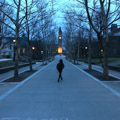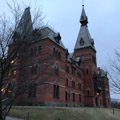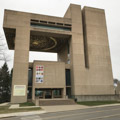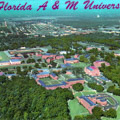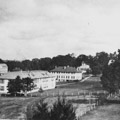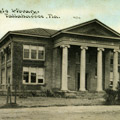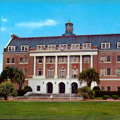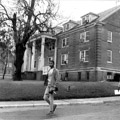The land-grant campus is, perhaps, the nation’s vernacular campus. Seemingly lacking coherence, a reasonably well-ordered core of academic and administrative buildings dressed in traditional styles often gives way to high-rises, parking lots, residential structures, roads, fields, barns, and outbuildings. Pathways, lawns, ponds, creeks, paths, and tree cover, occasionally mirroring the contours of the landscape, help to soften what might otherwise become a more jarring formal prospect, but consistency, order, and formality rarely provides the lasting impression. Many of the public land-grant campuses in the United States have been under frequent construction and reconstruction for more than 125 years, so their physical presence mirrors the economic, social, and political vicissitudes of the regional and national condition. Similar to the cities or towns that surround them and to which they have been historically linked, the land-grant campus—in its juxtapositions of order and disorder, harmony and cacophony, monumentality and informality, and much else in between—is the higher education representative of the nation’s common, vernacular landscape.
Any lack of coherence belies the monumental importance of the predominantly rural, and often remote land-grant campus, of which there are 112 in 2020—more than three-quarters of which have existed since 1891. The physical setting to millions of students, including several of the first public colleges providing education for African Americans and opportunities for women, the land-grant institution has been—and continues to be—a major player in the social, cultural, and economic growth of the United States. However, with the exception of thirty-six Indigenous colleges, as of 2020, provided with federal funding and recognized as federal land-grant institutions following the 1994 Improving America’s Schools Act, the campuses were established through the sale of approximately eleven million acres of land taken either forcibly or legislatively from Indigenous peoples in the nineteenth century. Land-grant institutions are thus also integral to the nation’s legacy of conquest and their campuses are enduring reminders of settler colonialism—a legacy with which the nation’s original land-grant institutions are only recently beginning to grapple. In this fashion, as well, land-grant colleges remain deeply rooted in the American landscape—and its soil.
The landscape connections are literal: the legislative impetus for establishing land-grant colleges was ostensibly to create institutions that would provide proper training in the extraction, processing, and management of natural resources for the advancement of America’s rising agricultural, industrial, and military empire. It is this relationship to the landscape, and specifically to agriculture and engineering, that differentiates the land-grant campus most explicitly from its higher educational brethren: those colleges established principally to instruct students in theology, law, and the classics. And yet as physical settings on the American landscape, architecturally diverse as they may be, land-grant campuses have been largely overlooked.
This is unsurprising, for the legacy of the land-grant college is, and has been, its mission to provide a “practical” education. It is in the original act of 1862, named for sponsoring legislator Justin Morrill of Vermont, that the land-grant college (and, by implication, the campus) was provided with this directive. Under that act, every state and territory in the country was granted 30,000 acres of federal land per congressional representative. States and territories then were given the authority to sell those lands for the purposes of creating an endowment to establish (or expand) at least one college where instruction in agriculture and “mechanic arts,” as well as military tactics, would accompany a traditional, liberal arts education.
All of the land offered for sale or development was taken from Indigenous peoples prior to the Morrill Act of 1862. Yet there was little federal land remaining east of the Mississippi at that time, so colleges in the more densely populated East and South were granted land parcels in the American West. For eastern and southern states, then, the federal government granted “scrips” (essentially, vouchers) providing title to land parcels, which the states could then sell to speculators. The money from those sales went into endowments for the creation of the land-grant colleges—money that remains on university ledgers today. Western states could choose to establish a new land-grant campus on some of the acreage granted to them under the act—or they could erect a new campus elsewhere using funds collected from the sale of these lands.
The stated purpose of the Morrill Act authorized land sales for educating “industrial classes in the several pursuits and professions of life”—a vision first championed in the mid-nineteenth century by publisher, statesman, and reformer Horace Greeley and Yale-educated farmer Jonathan Baldwin Turner. The land-grant institution, which was also directed to provide education in military tactics and the sciences, formally challenged the curricula of many existing colleges where costs—and thus admission—was inaccessible largely to anyone beyond an elite class.
In 1890, a second Morrill Act, the Agricultural College Act of 1890, was passed to provide, by annual appropriation, supplemental income to all states or territories with land-grant institutions—provided those institutions reversed policies on race-based admissions. In the American South, rather than desegregate existing land-grant colleges, the former Confederate states founded seventeen new colleges for Black students; today these colleges comprise nearly one-fifth of the nation’s Historically Black Colleges and Universities (HBCUs). In 1994, twenty-nine Indigenous colleges and universities were given land-grant status with the passage of the Equity in Educational Land-Grant Status Act (also known as the Improving America’s Schools Act). Today, the nation’s land-grant map includes large, predominantly urban institutions such as the University of Wisconsin, the Ohio State University, and the University of Kentucky, and small, remote tribal colleges such as Sisseton Wahpeton College on the Lake Traverse Reservation in South Dakota and Iḷisaġvik College on the Arctic Ocean in Utqiaġvik, Alaska. Coupled with the construction of agricultural experiment stations (as established by the 1887 Hatch Act) and a directive to bring college research directly to farms, fields, and residences (as mandated by the 1914 Smith-Lever Act), land-grant institutions today represent a commitment to the cultural and economic development of the United States.
This commitment did not always extend to the physical development of the land-grant campus. Indeed, neither the initial 1862 Morrill Act nor any of the subsequent acts provided specifications for the planning and design of the new campuses, experiment stations, or the expansion of existing colleges (several states, such as Michigan, Pennsylvania, Tennessee, and Iowa transformed existing institutions into their land-grant colleges; in New Jersey, what was originally the private, liberal arts Queen’s College, was designated the state’s land-grant institution and later reconstituted as Rutgers University). As a result, early campus development was mostly an ad hoc affair that varied from state to state, with trustees and newly appointed college presidents principally focused upon providing the necessary facilities for teaching, research, and residence than concerning themselves with architectural cohesion or stylistic consistency. John Anderson, the president of the Kansas State Agricultural College (now Kansas State University), the first land-grant institution to be built anew following the passage of the first Morrill Act, wished his college to feature “cheap, stone buildings, one or two stories, scattered among the trees” for “a little hamlet of thriving artisans built in the heart of rich and well-tilled fields.” The Kansas State Agricultural College, at least, would intentionally contrast with the nation’s “great” yet “typical” colleges, with their “imposing” edifices, “costly foundations, and tall, heavy walls.”
Those “typical” colleges were generally elite private institutions located along the urbanized mid-nineteenth-century eastern seaboard, their campuses marked loosely by enclosures bordered by elaborately detailed stone or brick buildings steeped in the western architectural canon; their designs and formality intended to instruct users as to proper mores and behavior. Harvard College, the College of New Jersey (later Princeton), and the College of Philadelphia (later the University of Pennsylvania) were among the more notable of such institutions, yet even the more open and non-sectarian institutions of Union College in Schenectady, New York, and the University of Virginia in Charlottesville, Virginia, nonetheless featured architectural elements and proportions steeped in the classical tradition, formal enclosures, grand axes, and family-like lodging conditions where faculty, students, and administrators lived within supervisory proximity. Many of these colleges remained indebted to their foundations in theological instruction and were originally set apart from the allegedly corrupting influences of the city—geographically by location and physically by gates or fences. Then, as now, their cohesive styles and tight-knit development provided an ideal setting, and image, for collegiate life.
Such campuses are the exception on the American landscape, not the rule. Yet they have been afforded an attention highly disproportionate to their overall numbers and size, and their influence, architecturally and otherwise, has been widespread. Even if newly appointed college presidents hoped to differentiate their public land-grant campus from that of the elite private college, most did not wish their campuses to resemble vocational or technical schools, so they looked to architectural tradition as they began constructing their permanent built environment. The so-called “Old Mains” or other related structures (large, multi-functional buildings that commonly housed varying combinations of administrative and faculty offices, classrooms, libraries, auditoriums, and recreational spaces) at many of the original land-grant institutions may not have precisely resembled buildings at the elite colleges, but their ornate, High Victorian flamboyance (which ranged from French Second Empire to Richardsonian Romanesque) and otherwise imposing presence suggested that their college leadership wished them to provide a moralizing effect on the students of the “industrial classes.” Indeed, the principal buildings at the new land-grant colleges in Arkansas, South Carolina (Clemson), Alabama (Auburn), West Virginia, Kentucky, New Hampshire, and Colorado (Colorado State), for example, with their combinations of arches, tympani, pilasters, garlands, aedicule, urns, crenellations, lombard bands, lancet windows, and quoins carved or shaped into basalt, limestone, granite, and brick suggested that boards of trustees and college presidents intended the buildings and landscapes of the land-grant institution to aspire to something beyond practicality. In this way, at least in the principal buildings for administration and teaching, the land-grant colleges were linked ideologically with the built environments of existing institutions of higher education.
The curricular differences between the new land-grant colleges and elite institutions differentiated them from one another. Because the curricula of a land-grant institution included courses in agriculture, engineering, and science, some building types and layouts not associated with elite college campuses, for example, rapidly became staples of the land-grant campus. These included greenhouses, barns, pens, and stables, as well as science (often chemistry) buildings with multiple chimneys necessary to ventilate their laboratories. Several land-grant institutions also established “campus farms” either contiguous to—or away from—the main campus grounds.
Meanwhile, planning for some of the new land-grant institutions took on a particularly informal guise in the manner of the picturesque, even if the conscious manipulation of the natural environment was intended to provide a sophisticated, intellectually uplifting and civilized setting for learning. This emerged in part because landscape architect Frederick Law Olmsted was involved in the early designs of several early rural land-grant campus plans, including the University of California at Berkeley and the University of Massachusetts at Amherst, while his sons’ firm, the Olmsted Brothers, continued the picturesque tradition for the landscapes of Iowa State University, Oregon State University, the University of Florida, the University of Idaho, and the University of Rhode Island. Olmsted’s plan for the University of Massachusetts at Amherst attempted to break down social hierarchies by making provisions for several buildings—a miniature campus community of sorts—across a carefully wrought landscape. A plan that provided for “small, modest buildings,” Olmsted thought, would be far more suitable, both physically and ideologically, to the needs of a rural land-grant college than a more rigid plan focused upon a single building. Though the plan for the University of Massachusetts at Amherst ultimately was not adopted, college officials at the University of Maine, Pennsylvania State University, Cornell University, and the Hampton Institute (which later became Virginia’s land-grant school for African Americans) either hired or consulted with Olmsted for their early landscape plans.
The overall informality and openness of nineteenth-century land-grant college plans established a flexibility by which campuses could readily accommodate new buildings and layouts, suggestive of their openness to a range of subjects and ideas. Thus, the axial, monumental planning that came to characterize the central sections of the University of California at Berkeley, the University of Illinois, the University of Missouri, and the University of Wisconsin by the early twentieth century was easily adapted to the land-grant campus. Indeed, several colleges and universities underwent major planning and building campaigns in the late nineteenth and early twentieth centuries, inspired by a national increase in enrollment. Perhaps most famous were the re-imaginations of well-endowed private institutions in the guise of the Collegiate Gothic: at Bryn Mawr College, Duke University, Northwestern University, Princeton University, the University of Chicago, Washington University in St. Louis, and Yale University. Programs showcasing buildings of varying styles emerged at non-land-grant, yet well-funded, public institutions as well, including Indiana University, the University of Michigan, the University of North Carolina, the University of Colorado, the University of Oklahoma, and the University of Washington.
Land-grant institutions attempted to measure up. In the early 1920s, for example, administrators at rural Washington State College (now Washington State University) in Pullman, Washington, invited San Francisco-based architect William Faville, then president of the American Institute of Architects, along with W. R. B. Willcox, professor of architectural engineering at the University of Oregon, to assess the campus potential. Faville, previously involved in the monumental plan for the University of Nevada, Reno, suggested that Washington State College could become “one of the most beautiful campuses in the West.” He presented a plan that assembled buildings in zones, convincing one student newspaper reporter to declare that the plan, if carried out, would make the campus “a splendid self-advertising medium.” By the late 1920s, the Washington State College core had become loosely enveloped by a handful of red-brick Georgian Revival residential and academic buildings, though there was no evident pattern to their layout. In the late 1930s, the college hired the Minnesota-based landscape architecture firm of Morell and Nichols to compose a more ordered configuration, but their monumental axes, rounded enclosures, formal landscaping, and outdoor amphitheaters fell victim to public funding and shifting administrative and financial priorities. With public land-grant colleges subjected to the inconsistencies of state appropriations, they had fewer opportunities to develop a cohesive architectural palette or carry out master plans to completion, unlike private institutions or public universities with larger endowments.
Several land-grant institutions nonetheless embarked upon building programs or campus planning to develop consistent architectural traditions in the early twentieth century, such as the Collegiate Gothic at the University of Florida, the Georgian Revival at Florida A & M, and the Pueblo Revival at New Mexico State University—but those efforts never created campuses of lasting order. Meanwhile, campuses such as the University of Nebraska, Colorado State University, the University of Arizona, and Utah State University began expanding their initial building arrangements to form central, if occasionally expansive, quadrangles, malls, or, in the case of the Ohio State University—ovals. In an attempt to protect students from the corrupting influences of the outside world (or off-campus housing), in the mid-1920s the University of Wisconsin arrayed two men’s residence halls around tightly enclosed quadrangles, blocking students’ views of the lake. In this fashion, the planning of land-grant campuses had begun to approach the appearance of the elite private colleges as well as some non-land-grant, yet well-funded, public institutions. Yet they were never quite as defined or consistent.
The major social and economic upheavals of the Depression and World War II ensured that architectural and planning consistency was not likely to control a national higher education agenda. The Servicemen’s Readjustment Act of 1944, commonly known as the GI Bill, provided free tuition to war veterans and their families, and student enrollment tripled at most colleges and universities nationwide—public and private, land grant and otherwise. By the mid-twentieth century, universities everywhere found themselves in need of hundreds of new facilities for residence, instruction, recreation, and research. An increase in automobile ownership, meanwhile, encouraged the development of ring roads and parking lots, extending campuses outward but also compelling their redevelopment from within. Older revival-style buildings in campus cores were soon juxtaposed with new, larger structures made of concrete, steel, and glass—or removed altogether. Swelling populations spurred the planning, design, and construction of entirely new campuses for the University of California in Santa Cruz, Santa Barbara, Irvine, San Diego, and Riverside.
By the 1970s, campuses everywhere began to reevaluate their older built environment as cherished parts of their heritage, encouraged by legislation permitting their listing on the National Register of Historic Places and a widespread belief that buildings and landscapes associated with the foundational years drove campus character. New construction often was guided by tradition, even to cultural heritage: the campus of the Fond du Lac Tribal and Community College in Minnesota is one such example. A late-twentieth and early-twenty-first-century high-stakes competition for increased enrollment, greater revenue, and enhanced prestige encouraged many universities, meanwhile, to hire noted architects to design amenity-filled, energy-reducing student centers, museums, athletic facilities, recreation centers, and residential halls.
By the late twentieth century, distinctions between land-grant college campuses and those of others had become far less evident. Only a general informality, large scale, and sprawling development, occasionally marked by new or specialized campuses serving particular functions, might have distinguished the land-grant campus. This had less to do with appearance than it did with greater attention paid to the land-grant mission of outreach and community engagement. Given the precipitous decline of public funding by the early twenty-first century and a greater recognition of the emergence of the land-grant institution in land deals that effectively ended Indigenous lifeways, attempting to delineate formal distinctions between types of campuses—even if they could be made—seems increasingly trivial.
And yet the presence—and the visibility—of the land remains, marked as much by the ordinary barns, stables, and tilled fields on the edges as it is by the varied building types and open spaces in the center. Tightly organized or not, that presence reminds us of the land-grant mission to uplift the industrial classes and transform the natural landscape for the economic advancement of the region. How this vernacular campus reconciles its buildings and spaces with the realities of the cultural origins of its soil may ultimately provide the most lasting features of its landscape.
References
Cross, Coy F. II. “Democracy, the West, and Land-Grant Colleges.” In Daniel Mark Fogel and Elizabeth Malson-Huddle, eds. Precipice or Crossroads? Where America’s Great Public Universities Stand Where They Are Going Midway through Their Second Century, 1-15. Albany: State University of New York, 2012.
“Faville Addresses ‘Forum’ Gathering.” The Evergreen (Washington State College, Pullman, WA), November 5, 1923.
Gravazzi, Stephen M., and E. Gordon Gee. Land Grant Universities for the Future: Higher Education for the Public Good. Baltimore: Johns Hopkins University Press, 2018.
Gumprecht, Blake. The American College Town. Amherst: University of Massachusetts Press, 2008.
Lee, Robert, and Tristan Ahtone. “Land-Grab Universities: Expropriated Indigenous Land is the Foundation of the Land-Grant University System.” High Country News (Paonia, CO), March 30, 2020.
Longstreth, Richard. “From Farm to Campus: Planning, Politics, and the Agricultural College Idea.” Winterthur Portfolio 20, no. 2/3 (Summer-Autumn, 1985): 149-179.
Nash, Margaret A. “Entangled Pasts: Land-Grant Colleges and American Indian Dispossession.” History of Education Quarterly 59, no. 4 (November 2019): 437-467.
National Association of State Universities and Land-Grant Colleges. The Land-Grant Tradition. Washington, D.C.: National Association of State Universities and Land-Grant Colleges, 2008.
“New Gym is Now Assured.” The Evergreen (Washington State College, Pullman, WA), October 31, 1923.
Page, Max, and Marla R. Miller. The Campus Guide: University of Massachusetts at Amherst. New York: Princeton Architectural Books, 2013.
Sorber, Nathan. Land-Grant Colleges and Popular Revolt: The Origins of the Morrill Act and the Reform of Higher Education. Ithaca: Cornell University Press, 2018.
Turner, Paul Venable. Campus: An American Planning Tradition. Cambridge: MIT Press, 1984.
Yanni, Carla. Living on Campus: An Architectural History of the American Dormitory. Minneapolis: University of Minnesota Press, 2019.
Writing Credits
If SAH Archipedia has been useful to you, please consider supporting it.
SAH Archipedia tells the story of the United States through its buildings, landscapes, and cities. This freely available resource empowers the public with authoritative knowledge that deepens their understanding and appreciation of the built environment. But the Society of Architectural Historians, which created SAH Archipedia with University of Virginia Press, needs your support to maintain the high-caliber research, writing, photography, cartography, editing, design, and programming that make SAH Archipedia a trusted online resource available to all who value the history of place, heritage tourism, and learning.

